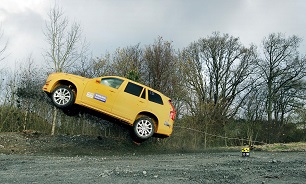Top 5 ways cars have gotten more dangerous
Yes, modern cars are safer, but not in every way.

Khodrocar - I drive a lot of cars and am amazed at how their safety has progressed to the point that we now walk away from crashes that would have killed everyone a few decades ago. But that doesn't mean modern cars are safer across the board: Here are the five ways I've noticed cars getting more dangerous while piling on the safety innovations.
5. Greater weight
Heavier cars are great if you're inside one, not so much if you're hit by one. A 1976 Honda Accord weighed about 1,900 pounds but the 2018 model weighs about 3,400 pounds. A 2011 study by researchers at UC Berkeley found that for every 1,000 pounds more weight in the car that hits yours, there is a 47 percent increase in the likelihood you will be killed. The irony is that a lot of this weight gain has come from the addition of safety equipment and design.
4. Higher power
While cars got a lot heavier, they also got a lot more powerful, and speed kills -- or at least the unintended rapid reduction of it does! Our sample 2018 Honda Accord has a ratio of power to weight almost 50 percent higher than the 1976 model, and we aren't even talking about a performance car. You find that trend in almost every car made over the last few decades, and it can get the inattentive or idiotic driver in more trouble faster.
3. Dark windows
5. Greater weight
Heavier cars are great if you're inside one, not so much if you're hit by one. A 1976 Honda Accord weighed about 1,900 pounds but the 2018 model weighs about 3,400 pounds. A 2011 study by researchers at UC Berkeley found that for every 1,000 pounds more weight in the car that hits yours, there is a 47 percent increase in the likelihood you will be killed. The irony is that a lot of this weight gain has come from the addition of safety equipment and design.
4. Higher power
While cars got a lot heavier, they also got a lot more powerful, and speed kills -- or at least the unintended rapid reduction of it does! Our sample 2018 Honda Accord has a ratio of power to weight almost 50 percent higher than the 1976 model, and we aren't even talking about a performance car. You find that trend in almost every car made over the last few decades, and it can get the inattentive or idiotic driver in more trouble faster.
3. Dark windows
It seems like every car has heavy tint these days, from legally dubious homebrew jobs to the factory privacy glass on SUVs and crossovers. Deep tint turns a car into a massive opaque object able to easily block your view of a bike, pedestrian or other car on the far side of it. And pulling out of a driveway or side street into traffic is a white-knuckled affair when you are nosing out between a couple of dark tinted vehicles.
2. Reduced visibility
Big rumps, high waists, and bodacious pillars dominate modern car design for reasons that range from rollover crash survival to aerodynamics and contemporary style. But all of these conspire to reduce outward visibility. Cameras have proliferated in cars, but I don't find them to be a faithful substitute for organic visibility. Maybe that's why Jaguar Land Rover has been developing a way to make pillars virtually disappear while you drive.
1. Distraction
Never mind the handheld devices we bring to cars, the reality is that cars themselves are never going retreat from presenting an array of text, visuals and menus that beg us to pay attention to them. The nature of electronics is to deliver user experience via software, and the nature of software is to adding more interactivity because its easy. The intersection of that built-in distraction with the previous four factors in my list makes the consequences of distraction even greater. And you wonder why autonomous cars are coming.
2. Reduced visibility
Big rumps, high waists, and bodacious pillars dominate modern car design for reasons that range from rollover crash survival to aerodynamics and contemporary style. But all of these conspire to reduce outward visibility. Cameras have proliferated in cars, but I don't find them to be a faithful substitute for organic visibility. Maybe that's why Jaguar Land Rover has been developing a way to make pillars virtually disappear while you drive.
1. Distraction
Never mind the handheld devices we bring to cars, the reality is that cars themselves are never going retreat from presenting an array of text, visuals and menus that beg us to pay attention to them. The nature of electronics is to deliver user experience via software, and the nature of software is to adding more interactivity because its easy. The intersection of that built-in distraction with the previous four factors in my list makes the consequences of distraction even greater. And you wonder why autonomous cars are coming.
Source: cnet.com
Latest News


